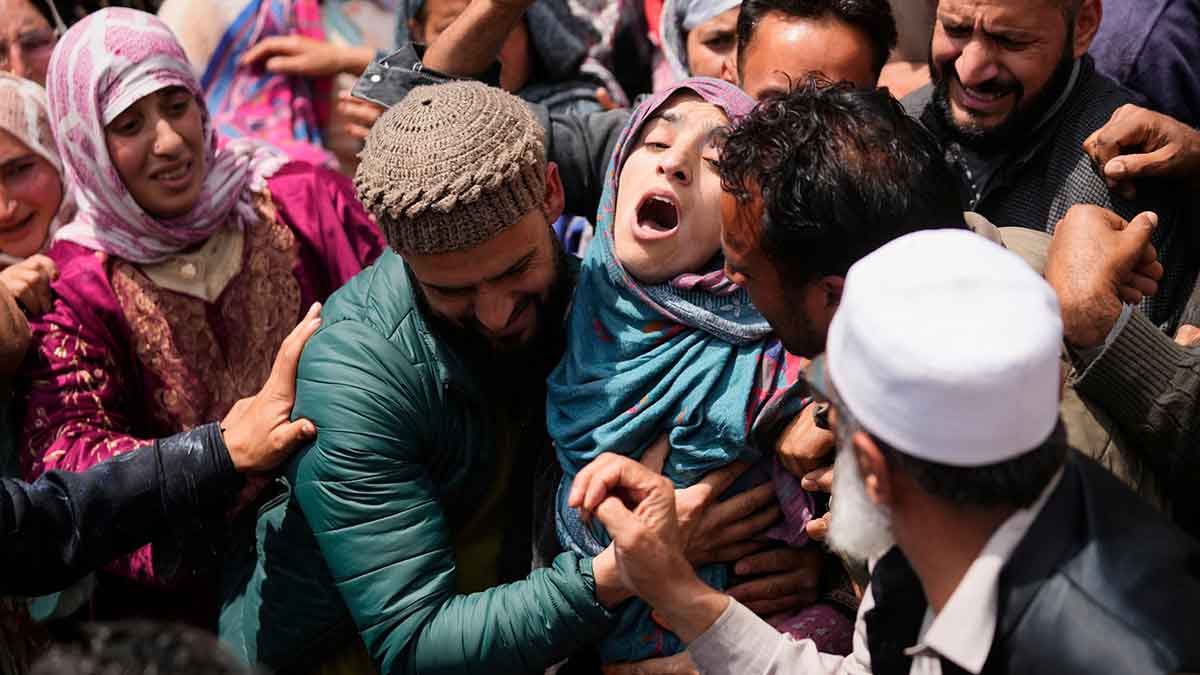Why Baisaran? Why not Srinagar or Pahalgam proper?
 When terror came calling: A relative cries during the funeral procession of Adil Hussain Shah, a daily wage worker who was killed by the terrorists | AP
When terror came calling: A relative cries during the funeral procession of Adil Hussain Shah, a daily wage worker who was killed by the terrorists | AP
WHEN HAMAS UNLEASHED a savage attack on Israel on October 7, 2023, there were apprehensions in the Indian security establishment about similar attacks being staged in India’s hotspots. On April 22, those fears came true at the picturesque Baisaran bowl in Pahalgam, in Kashmir’s Anantnag district.
The terror attack had several immediate objectives. One, to kill as many tourists as possible for maximum effect―many were shot at point blank range. Two, to fan communal hatred―victims were asked to recite the ‘kalma’. And three, to be seen as ‘charitable’ in an eerie way, as women and children were spared.
The location was chosen because it is a must-visit for any tourist on a Kashmir sojourn. The bowl-shaped valley surrounded by the snow-clad peaks is not easily accessible, and the security forces would take time to react, was another reason.
The attack took place on the day Prime Minister Narendra Modi embarked on an official visit to Saudi Arabia. A reformist agenda in the kingdom under Crown Prince Mohammed bin Salman included a re-look at the Kashmir issue. Last year, Saudi Arabia had backed the Indian position of resolving the issue bilaterally between India and Pakistan.
Being a leading energy supplier to India, Saudi Arabia is a major stakeholder in the IMEC (India–Middle East–Europe Economic Corridor). IMEC aims to link India, the Middle East and Europe and boost trade. Besides, Saudi Arabia has already committed $100 billion investment in India in a few years.
Also, the attack happened when US Vice President JD Vance was in India, and put the focus back on the Kashmir issue. This is not incidental. On March 20, 2000, unidentified men armed with automatic weapons killed 36 Sikhs in Anantnag district’s Chittisinghpura village. President Bill Clinton was in India at the time. Two years later, on May 14, 2002, terrorists attacked a bus near Kaluchak in Jammu, shot seven civilians before entering a residential zone of the Army and killed 23 people, including 10 children and eight women. This was when US Assistant Secretary of State for South Asian Affairs Christina B. Rocca was on an official visit to India.
Three days before the Pahalgam attack, on April 19, Pakistan had inked an agreement with Afghanistan against allowing the use of their territories for terror attacks against each other. The pact was signed during Pakistan Foreign Minister Ishaq Dar’s one-day visit to Afghanistan. The implication of the agreement in the Indian context is that with the border with Afghanistan taken care of, Pakistan-based terrorists could easily be steered to Kashmir.
The big question now is what will New Delhi do? In the past decade, India has militarily retaliated twice against Pakistan. Responding to a terror attack on an Army brigade headquarters camp in Uri on September 18, 2016, Indian soldiers crossed the Line of Control (LoC) ten days later and reportedly killed about 150 Pakistan-supported terrorists. Retaliating against a terror bombing on an Army convoy ferrying soldiers on February 14, 2019, at Lethpora in Jammu and Kashmir’s Pulwama district, Indian Air Force fighter aircraft bombed a terrorist training camp 12 days later after crossing the LoC.
A retired top Army officer, on condition of anonymity, identified a key issue concerning retaliatory action. “The government not only has to conduct retaliatory action but has also to be seen doing it,” he said. “The optics has to be strong enough.”
The Week